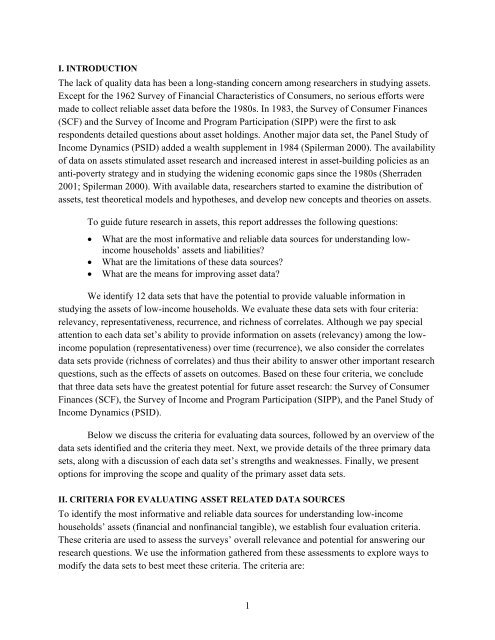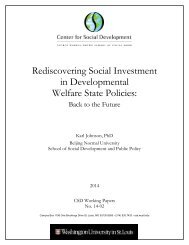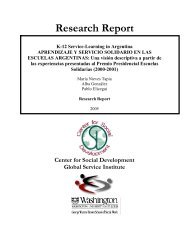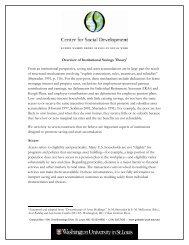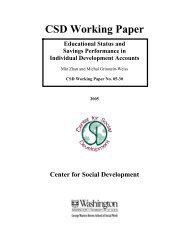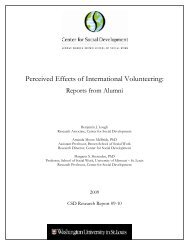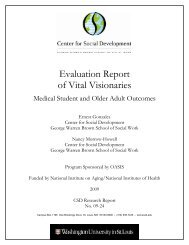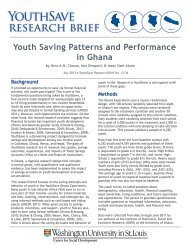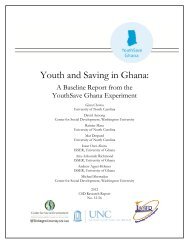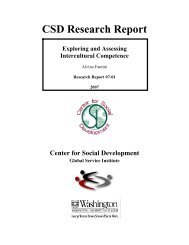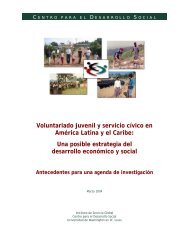Assessing Asset Data on Low-Income Households - Urban Institute
Assessing Asset Data on Low-Income Households - Urban Institute
Assessing Asset Data on Low-Income Households - Urban Institute
You also want an ePaper? Increase the reach of your titles
YUMPU automatically turns print PDFs into web optimized ePapers that Google loves.
I. INTRODUCTION<br />
The lack of quality data has been a l<strong>on</strong>g-standing c<strong>on</strong>cern am<strong>on</strong>g researchers in studying assets.<br />
Except for the 1962 Survey of Financial Characteristics of C<strong>on</strong>sumers, no serious efforts were<br />
made to collect reliable asset data before the 1980s. In 1983, the Survey of C<strong>on</strong>sumer Finances<br />
(SCF) and the Survey of <strong>Income</strong> and Program Participati<strong>on</strong> (SIPP) were the first to ask<br />
resp<strong>on</strong>dents detailed questi<strong>on</strong>s about asset holdings. Another major data set, the Panel Study of<br />
<strong>Income</strong> Dynamics (PSID) added a wealth supplement in 1984 (Spilerman 2000). The availability<br />
of data <strong>on</strong> assets stimulated asset research and increased interest in asset-building policies as an<br />
anti-poverty strategy and in studying the widening ec<strong>on</strong>omic gaps since the 1980s (Sherraden<br />
2001; Spilerman 2000). With available data, researchers started to examine the distributi<strong>on</strong> of<br />
assets, test theoretical models and hypotheses, and develop new c<strong>on</strong>cepts and theories <strong>on</strong> assets.<br />
To guide future research in assets, this report addresses the following questi<strong>on</strong>s:<br />
• What are the most informative and reliable data sources for understanding lowincome<br />
households’ assets and liabilities?<br />
• What are the limitati<strong>on</strong>s of these data sources?<br />
• What are the means for improving asset data?<br />
We identify 12 data sets that have the potential to provide valuable informati<strong>on</strong> in<br />
studying the assets of low-income households. We evaluate these data sets with four criteria:<br />
relevancy, representativeness, recurrence, and richness of correlates. Although we pay special<br />
attenti<strong>on</strong> to each data set’s ability to provide informati<strong>on</strong> <strong>on</strong> assets (relevancy) am<strong>on</strong>g the lowincome<br />
populati<strong>on</strong> (representativeness) over time (recurrence), we also c<strong>on</strong>sider the correlates<br />
data sets provide (richness of correlates) and thus their ability to answer other important research<br />
questi<strong>on</strong>s, such as the effects of assets <strong>on</strong> outcomes. Based <strong>on</strong> these four criteria, we c<strong>on</strong>clude<br />
that three data sets have the greatest potential for future asset research: the Survey of C<strong>on</strong>sumer<br />
Finances (SCF), the Survey of <strong>Income</strong> and Program Participati<strong>on</strong> (SIPP), and the Panel Study of<br />
<strong>Income</strong> Dynamics (PSID).<br />
Below we discuss the criteria for evaluating data sources, followed by an overview of the<br />
data sets identified and the criteria they meet. Next, we provide details of the three primary data<br />
sets, al<strong>on</strong>g with a discussi<strong>on</strong> of each data set’s strengths and weaknesses. Finally, we present<br />
opti<strong>on</strong>s for improving the scope and quality of the primary asset data sets.<br />
II. CRITERIA FOR EVALUATING ASSET RELATED DATA SOURCES<br />
To identify the most informative and reliable data sources for understanding low-income<br />
households’ assets (financial and n<strong>on</strong>financial tangible), we establish four evaluati<strong>on</strong> criteria.<br />
These criteria are used to assess the surveys’ overall relevance and potential for answering our<br />
research questi<strong>on</strong>s. We use the informati<strong>on</strong> gathered from these assessments to explore ways to<br />
modify the data sets to best meet these criteria. The criteria are:<br />
1


